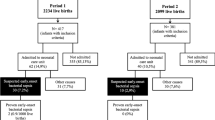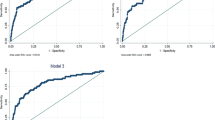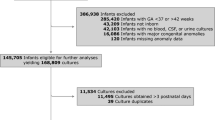Abstract
OBJECTIVE: To assess the role of intrapartum fever in identifying asymptomatic term neonates with early-onset neonatal sepsis.
STUDY DESIGN: Retrospective review of all term neonates with sepsis over a 7-year period to evaluate the significance of symptoms at delivery and intrapartum sepsis risks factors in identifying neonates with sepsis.
RESULTS: Fifty-three of 90 term neonates with sepsis (59%) were asymptomatic at delivery. Thirty-five of 53 asymptomatic term neonates (66%) met criteria for sepsis evaluations and 18 (34%) were evaluated when symptoms developed after delivery. Among the 35 asymptomatic term neonates meeting criteria for sepsis evaluations, 14 (40%) had evaluations because of intrapartum fever. Thus, 14 of 53 (26%) asymptomatic term neonates with sepsis (30% of GBS sepsis and 11% of non-GBS sepsis) would not have been evaluated if intrapartum fever were ignored.
CONCLUSION: Over half of term neonates with sepsis were asymptomatic at delivery. Intrapartum fever was helpful in identifying over a quarter of asymptomatic term neonates with sepsis.
This is a preview of subscription content, access via your institution
Access options
Subscribe to this journal
Receive 12 print issues and online access
$259.00 per year
only $21.58 per issue
Buy this article
- Purchase on Springer Link
- Instant access to full article PDF
Prices may be subject to local taxes which are calculated during checkout

Similar content being viewed by others
References
Klein JO . Bacterial sepsis and meningitis In: Remington JS, Klein JO, editors Infectious Diseases of the Fetus and Newborn Infant Philadelphia: WB Saunders 2001 p 949–55
Karpuch J, Goldberg M, Kohelet D . Neonatal bacteremia. A 4-year prospective study Isr J Med Sci 1983 19: 963–6
Escobar GJ, Li DK, Armstrong MA et al. Neonatal sepsis workups in infants ≥2000 grams at birth: a population-based study Pediatrics 2000 106: 256–63
Lieberman E, Lang JM, Frigoletto F Jr, Richardson DK, Singer SA, Cohen A . Epidural analgesia, intrapartum fever, and neonatal sepsis evaluation Pediatrics 1997 99: 415–9
Gerdes JS . Clinicopathologic approach to the diagnosis of neonatal sepsis Clin Perinatol 1991 18: 361–81
Allen SR . Management of asymptomatic term neonates whose mothers received intrapartum antibiotics: Part 1. Rationale for intrapartum antibiotic therapy Clin Pediatr (Philadelphia) 1997 36: 563–8
Bromberger P, Lawrence JM, Braun D, Saunders B, Contreras R, Petitti DB . The influence of intrapartum antibiotics on the clinical spectrum of early-onset group B streptococcal infection in term infants Pediatrics 2000 106: 244–50
Gladstone IM, Ehrenkranz RA, Edberg SC, Baltimore RS . A ten-year review of neonatal sepsis and comparison with the previous fifty-year experience Pediatr Infect Dis J 1990 9: 819–25
Fusi L, Steer PJ, Maresh MJ, Beard RW . Maternal pyrexia associated with the use of epidural analgesia in labour Lancet 1989 1: 1250–2
Camann WR, Hortvet LA, Hughes N, Bader AM, Datta S . Maternal temperature regulation during extradural analgesia for labour Br J Anaesth 1991 67: 565–8
Herbst A, Wolner-Hanssen P, Ingemarsson I . Risk factors for fever in labor Obstet Gynecol 1995 86: 790–4
Gonen R, Korobochka R, Degani S, Gaitini L . Association between epidural analgesia and intrapartum fever Am J Perinatol 2000 17: 127–30
Philip J, Alexander JM, Sharma SK, Leveno KJ, McIntire DD, Wiley J . Epidural analgesia during labor and maternal fever Anesthesiology 1999 90: 1271–5
Decreasing incidence of perinatal Group B streptococcal disease—United States, 1993–1995 MMWR, Morb Mortal Wkly Rep 1997 46: 473–7
Schrag SJ, Zywicki S, Farley MM et al. Group B streptococcal disease in the era of intrapartum antibiotic prophylaxis N Engl J Med 2000 342: 15–20
Factor SH, Whitney CG, Zywicki SS, Schuchat A . Effects of hospital policies based on 1996 group B streptococcal disease consensus guidelines. The Active Bacterial Core Surveillance Team Obstet Gynecol 2000 95: 377–82
Gilson GJ, Christensen F, Romero H, Bekes K, Silva L, Qualls CR . Prevention of group B Streptococcus early-onset neonatal sepsis: comparison of the Center for Disease Control and prevention screening-based protocol to a risk-based protocol in infants at greater than 37 weeks' gestation J Perinatol 2000 20: 491–5
Acknowledgements
We thank Andrew Onderdonk and Margaret McLaughlin for their assistance with the microbiology laboratory database, Ruth Tuomala and Eric Eichenwald for consultation, and Audrey Ho for data abstraction.
Author information
Authors and Affiliations
Rights and permissions
About this article
Cite this article
Chen, K., Ringer, S., Cohen, A. et al. The Role of Intrapartum Fever in Identifying Asymptomatic Term Neonates With Early-Onset Neonatal Sepsis. J Perinatol 22, 653–657 (2002). https://doi.org/10.1038/sj.jp.7210818
Published:
Issue Date:
DOI: https://doi.org/10.1038/sj.jp.7210818



